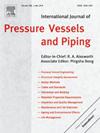Numerical and experimental analysis of welding parameters on residual stress in stainless steel 304L using ultrasonic methods
IF 3.5
2区 工程技术
Q2 ENGINEERING, MECHANICAL
International Journal of Pressure Vessels and Piping
Pub Date : 2025-10-01
DOI:10.1016/j.ijpvp.2025.105665
引用次数: 0
Abstract
Residual stresses generated by the welding process have a significant impact on the structural performance and service life of components. In this study, the effects of welding speed and current on longitudinal residual stresses in AISI 304L austenitic stainless steel (SS 304L) were investigated using both experimental and numerical approaches. Residual stresses were measured at a depth of 1.5 mm using longitudinal critically refracted (Lcr) ultrasonic waves, and the acoustoelastic coefficients of the base metal and weld metal were determined through uniaxial tensile testing. Numerical simulations of the welding process were conducted using ABAQUS software.
The results showed that residual stresses in the weld metal region are tensile and gradually shift toward compressive values with increasing distance from the weld center. Increasing the welding speed reduced the magnitude of residual stresses, whereas increasing the current led to an increase in residual stress levels. A comparison between the numerical simulation and experimental ultrasonic measurements revealed an average discrepancy of 27 MPa in the weld metal region (equivalent to 15 %) and 10 MPa in the base metal region (equivalent to 12 %). The maximum observed difference between the numerical and experimental results was 40 MPa at the weld line and 39 MPa in the base metal. The findings of this study demonstrate the effectiveness of combining ultrasonic testing and finite element simulation in analyzing and optimizing welding parameters and predicting residual stress distributions.
用超声方法对304L不锈钢焊接参数对残余应力的影响进行数值和实验分析
焊接过程中产生的残余应力对构件的结构性能和使用寿命有重大影响。采用实验和数值方法研究了焊接速度和电流对AISI 304L奥氏体不锈钢(SS 304L)纵向残余应力的影响。利用纵向临界折射(Lcr)超声波测量1.5 mm深度处的残余应力,并通过单轴拉伸测试确定母材和焊缝金属的声弹性系数。利用ABAQUS软件对焊接过程进行了数值模拟。结果表明:随着离焊缝中心距离的增加,焊缝金属区的残余应力以拉伸为主,逐渐向压缩方向转移;提高焊接速度可减小残余应力的大小,而增加焊接电流可增大残余应力的大小。数值模拟与实验超声测量结果的对比表明,焊缝金属区域的平均差异为27 MPa(相当于15%),母材区域的平均差异为10 MPa(相当于12%)。观察到的数值与实验结果之间的最大差异为焊缝处40 MPa,母材处39 MPa。研究结果验证了超声检测与有限元模拟相结合在分析和优化焊接参数以及预测残余应力分布方面的有效性。
本文章由计算机程序翻译,如有差异,请以英文原文为准。
求助全文
约1分钟内获得全文
求助全文
来源期刊
CiteScore
5.30
自引率
13.30%
发文量
208
审稿时长
17 months
期刊介绍:
Pressure vessel engineering technology is of importance in many branches of industry. This journal publishes the latest research results and related information on all its associated aspects, with particular emphasis on the structural integrity assessment, maintenance and life extension of pressurised process engineering plants.
The anticipated coverage of the International Journal of Pressure Vessels and Piping ranges from simple mass-produced pressure vessels to large custom-built vessels and tanks. Pressure vessels technology is a developing field, and contributions on the following topics will therefore be welcome:
• Pressure vessel engineering
• Structural integrity assessment
• Design methods
• Codes and standards
• Fabrication and welding
• Materials properties requirements
• Inspection and quality management
• Maintenance and life extension
• Ageing and environmental effects
• Life management
Of particular importance are papers covering aspects of significant practical application which could lead to major improvements in economy, reliability and useful life. While most accepted papers represent the results of original applied research, critical reviews of topical interest by world-leading experts will also appear from time to time.
International Journal of Pressure Vessels and Piping is indispensable reading for engineering professionals involved in the energy, petrochemicals, process plant, transport, aerospace and related industries; for manufacturers of pressure vessels and ancillary equipment; and for academics pursuing research in these areas.

 求助内容:
求助内容: 应助结果提醒方式:
应助结果提醒方式:


